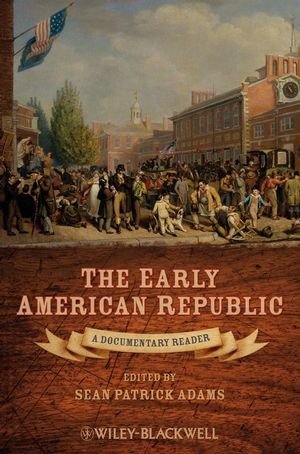|
Textbook
The Early American Republic: A Documentary ReaderISBN: 978-1-4051-6098-8
Paperback
240 pages
September 2008, ©2008, Wiley-Blackwell
 This is a Print-on-Demand title. It will be printed specifically to fill your order. Please allow an additional 10-15 days delivery time. The book is not returnable.
Other Available Formats: Hardcover
|
||||||
Series Editors’ Preface.
Acknowledgments.
Introduction: Traveling the Early American Republic.
Part I Building the United States:.
1. Origins.
1 First Inaugural Address of George Washington, 1789.
2 Tickagiska King Addresses President George Washington, 1789.
3 Western Pennsylvanians Petition Against Taxes, 1790.
2. The First American Party System.
1 A Federalist Appeal to Voters, 1792.
2 Abigail Adams on the Partisan Press, 1797.
3 Matthew Lyon Criticizes “Aristocratic” Politics, 1797.
4 A Massachusetts Farmer Attacks the Federalists, 1798.
3. Recasting the American Nation.
1 First Inaugural Address of Thomas Jefferson, 1801.
2 A New Name for the United States?, 1803.
3 Rules of Etiquette in Jefferson’s White House, 1803.
Part II Clashes East and West:.
4. Whose Land?.
1 Lewis and Clark Make American Claims in the “Great West,” 1805.
2 Tecumseh Speaks Out Against American Policy in the Old Northwest, 1810.
3 An Artist’s Depiction of Scalping during the War of 1812, 1812.
5 Conflict on Many Fronts.
1 James Madison Justifies War with the British, 1812.
2 The Hartford Convention Denounces the War, 1814.
3 An Eyewitness Account of the Battle of New Orleans, 1816.
Part III The Postwar Nation Looks Forward:.
6. The Year 1819 in Image and Verse.
1 A Poem about a Panic, 1819.
2 Americans on Their Way to a Camp Revival, 1819.
3 A Satirist Looks at the American Militia, 1819.
7. The Future Course of the Republic?.
1 John C. Calhoun Promotes Federal Internal Improvements, 1817.
2 The American Colonization Society Appeals to Congress, 1820.
3 Maine Answers the “Missouri Question,” 1820.
Part IV The Work of a New Republic:.
8. A Nation on the Move.
1 A Western Editor Endorses “Old Hickory,” 1824.
2 The Erie Canal Hits the American Stage, 1830.
3 An Englishwoman Remembers Her First Illinois Winter, 1848.
4 Charles Ball Describes Moving in the Slave Trade, 1837.
9. Work at Home, Factory, and Field.
1 Lydia Maria Child on the Family Economy and Soapmaking, 1830.
2 Two Views on the Morality of Capitalism in the Early Republic, 1834 and 1836.
3 Henry Bibb Describes Slave Labor in the Cotton Fields, 1849.
10. A New Urban America.
1 Frances Trollope Describes Cincinnati, 1832.
2 A Poem Composed to Cholera (1832).
3 A Raucous Omnibus Ride in New York City, 1839.
Part V Renewal and Reform:.
11. The Soul of the Republic.
1 Radical Quakers Appeal to Frances Wright, 1828.
2 Rev. Charles Finney on Changing One’s Own Heart, 1836.
3 Zilpha Elaw Remembers Preaching in the North and South, 1846.
12. Improvement of Body and Soul.
1 Boston Physicians on Temperance, 1832.
2 Mathew Carey Advocates Reform for Seamstresses, 1833.
3 Sylvester Graham Denounces “The Appetites,” 1837.
13. Anti-Slavery to Abolition.
1 African-American Leaders Reject Colonization Schemes, 1831.
2 Declaration of Sentiments of the American Anti-Slavery Society, 1833.
9. Maria Stewart Speaks at the African Masonic Hall (1833).
Part VI Jackson’s America:.
14. The Rise of the “Common Man”.
1 The Inauguration of Andrew Jackson, 1829.
2 David Walker Describes the Condition of Free African-Americans, 1829.
3 Sarah Grimké Defends the Rights of Women, 1837.
15. Native Americans and the Common Man.
1 Andrew Jackson Attempts to Justify Indian Removal to Congress, 1830.
2 John Ross Explains the Position of the Cherokee Nation, 1834.
3 A Description of Native American Removal in Tennessee, 1835.
16. The Second American Party System.
1 A Violent Election Season in New York City, 1834.
2 Henry Clay on Whig Strategy, 1838.
3 New Hampshire Papers Debate the “Log Cabin” Campaign, 1840.
Part VII The American Continent:.
17. The Mississippi and Beyond.
1 Narcissa Whitman Describes Missionary Life in Oregon, 1836.
2 George Catlin Describes the Mandan Buffalo Dance, 1841.
3 Notchininga’s Map of the Upper Mississippi, 1837.
18. The Era of Manifest Destiny.
1 Sam Houston’s Inaugural Address for the Republic of Texas, 1836.
2 An Editor Endorses the Idea of “Manifest Destiny,” 1845.
3 Walter Colton on the Discovery of Gold in California, 1850.
19. War with Mexico.
1 President Polk’s War Message, 1846.
2 An American Sergeant’s Perspective on the War with Mexico, 1847.
3 Guillermo Prieto Describes the Occupation of Mexico City, 1850.
Epilogue: The President and the Ex-Slave:.
1 Zachary Taylor’s Inaugural Address, 1849.
2 Frederick Douglass on “Morals and Men,” 1849.
Bibliography.
Index



